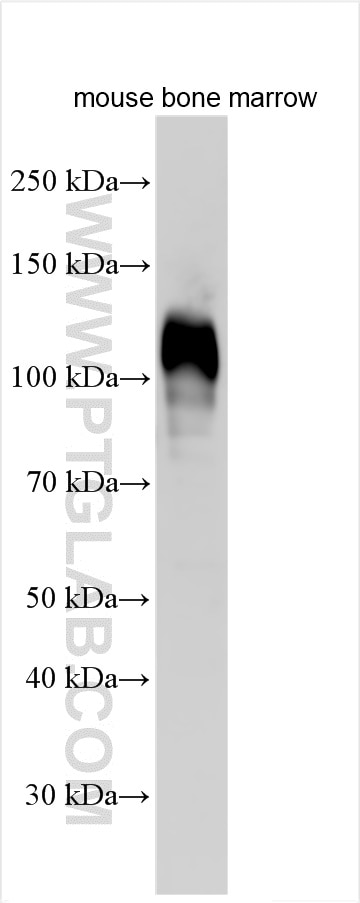Validation Data Gallery
Tested Applications
| Positive WB detected in | mouse bone marrow |
Recommended dilution
| Application | Dilution |
|---|---|
| Western Blot (WB) | WB : 1:1000-1:8000 |
| It is recommended that this reagent should be titrated in each testing system to obtain optimal results. | |
| Sample-dependent, Check data in validation data gallery. | |
Product Information
18264-1-AP targets CD177 in WB, ELISA applications and shows reactivity with human, mouse samples.
| Tested Reactivity | human, mouse |
| Host / Isotype | Rabbit / IgG |
| Class | Polyclonal |
| Type | Antibody |
| Immunogen | CD177 fusion protein Ag13146 相同性解析による交差性が予測される生物種 |
| Full Name | CD177 molecule |
| Calculated molecular weight | 437 aa, 46 kDa |
| Observed molecular weight | 100-130 kDa |
| GenBank accession number | BC029167 |
| Gene Symbol | CD177 |
| Gene ID (NCBI) | 57126 |
| RRID | AB_3085560 |
| Conjugate | Unconjugated |
| Form | Liquid |
| Purification Method | Antigen affinity purification |
| UNIPROT ID | Q8N6Q3 |
| Storage Buffer | PBS with 0.02% sodium azide and 50% glycerol pH 7.3. |
| Storage Conditions | Store at -20°C. Stable for one year after shipment. Aliquoting is unnecessary for -20oC storage. |
Background Information
CD177, also known as NB1, HNA-2a or PRV-1, is a glycosylphosphatidylinositol (GPI)-anchored glycoprotein that belongs to the uPAR/CD59/Ly6 snake toxin superfamily (PMID: 17898576). It is expressed exclusively by neutrophils, neutrophilic metamyelocytes, and myelocytes (PMID: 17580308). CD177 interacts with β2 integrin CD11b/CD18 and CD11a/CD18, PECAM-1, and participates in neutrophil activation and transmigration (PMID: 17580308; 21193407). CD177 has been identified as a useful biomarker for myeloproliferative diseases (PMID: 17898576).
Protocols
| Product Specific Protocols | |
|---|---|
| WB protocol for CD177 antibody 18264-1-AP | Download protocol |
| Standard Protocols | |
|---|---|
| Click here to view our Standard Protocols |
